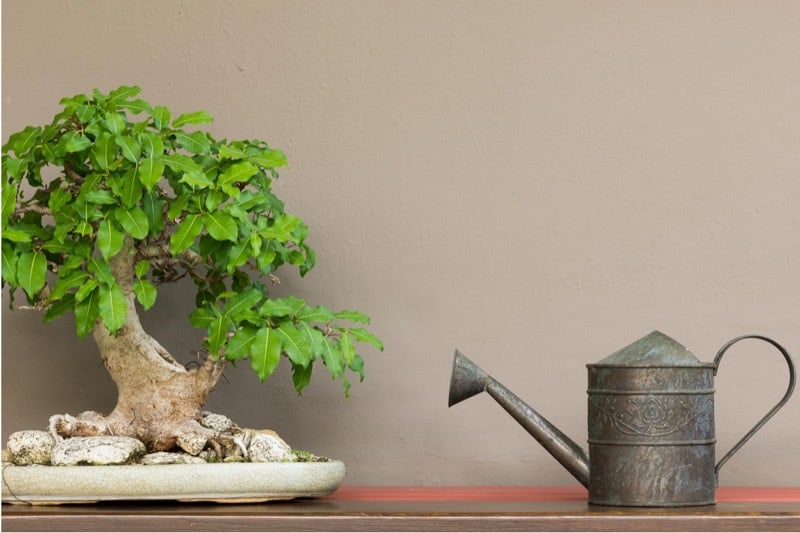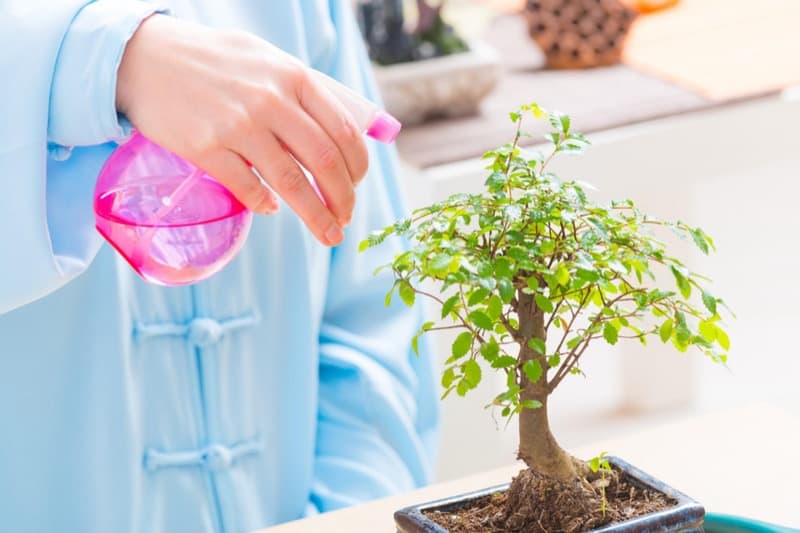Watering a bonsai tree might seem straightforward, but it’s an art that balances the needs of the tree with the conditions around it. Wondering how often to water bonsai? The answer isn’t one-size-fits-all. It depends on the type of bonsai, its pot size, the soil, and the weather.
This guide dives into the specifics: from daily watering in the heat to less frequent sips in cooler times. I’ll show you how to tell when your bonsai is thirsty, ensuring you keep its roots happy without drowning them.
Ready to master the watering can for your bonsai? Let’s explore the perfect watering routine that keeps your miniature tree thriving, no matter the season.
- Related article: Bonsai Growing Guide
6 Key Takeaways on How Often to Water Bonsai Trees
- Bonsai trees require regular watering, but the frequency depends on factors like species, pot size, and climate.
- Water your bonsai when the top layer of soil feels slightly dry, avoiding both overwatering and underwatering.
- Tropical bonsai trees generally need more frequent watering, while deciduous and coniferous bonsai require less.
- Misting can help increase humidity but should not replace regular watering to prevent root rot.
- Signs of overwatering include yellowing leaves, wilting, and a sour soil smell, indicating the need to reduce watering.
- Using a soil pH meter can help accurately monitor soil moisture levels and prevent overwatering.
How Often Should You Water a Bonsai Tree?

Bonsai trees need just the right amount of water, and how often you water them depends on a few things. These include the type of bonsai, the size of its pot, the soil it’s in, and the weather around it.
Most of the time, you’ll water your bonsai every few days. But in hot weather, it might be daily. When it’s cooler, every few days could be enough. The key is to check the soil.
Water your bonsai when the top of the soil is a bit dry. If it’s still dark and feels wet, wait a bit. If it’s light brown and dry, it’s time to give it a drink.
When you water, make sure the soil gets evenly moist, but don’t let it sit in water. Water until you see some drip out of the pot’s bottom. This way, all the roots get water.
Use a gentle pour so the soil surface gets covered evenly. If the soil is too dry, you can soak the pot in water for a short time to help it soak up moisture slowly.
Water Requirements for Different Bonsai Trees
Bonsai trees each have their own way of asking for water. Knowing what your bonsai needs is key to keeping it happy.
Here’s a simple guide to help you water your bonsai just right, no matter the type.
| Type of Bonsai Tree | Examples | Watering Needs | Soil Conditions |
|---|---|---|---|
| Tropical Bonsai Trees | Ficus retusa Carmona microphylla Serissa foetida | High water requirements — water daily, especially in the growing season. Misting helps maintain humidity. | Soil should always be moist but not waterlogged. Check if the soil surface feels light brown and dry. |
| Deciduous Bonsai Trees | Acer palmatum Ulmus parvifolia | Less water needed — water every few days in warmer months and reduce to every couple of weeks in winter. | Soil should dry out slightly between waterings to avoid root rot. |
| Coniferous Bonsai Trees | Pinus Juniperus species | Prefer drier conditions — water every few days during the growing season, avoiding overwatering. | Soil should be well-draining and allowed to dry out slightly between waterings. More tolerant of occasional underwatering. |
- Learn about the Right Bonsai Soil Mix
How Do I Know If My Bonsai Needs Water?
Determine when to water your bonsai by observing the following:
Soil Surface:
- If the top layer of soil appears light brown and feels dry to the touch, it’s time to water.
- If the soil looks dark and feels wet, delay watering.
Tree’s Leaves:
- Droopy or crispy leaves may signal water loss
- Leaves of Bonsai are falling off
It’s also important to do regular checks. Check soil moisture daily, especially in warmer months.
Additional Tips:
- If the soil surface becomes hard, consider submerging the bonsai in water briefly to allow even moisture absorption.
- Ensure the bonsai has access to water but avoid standing in it, as prolonged exposure can lead to root rot.
How to Water a Bonsai Tree
Keep these tips in mind when watering your Bonsai trees:
- Repeat Regularly – Make it a habit to check the soil moisture daily, especially during hot weather, to maintain the right water levels.
- Check Soil Moisture – Begin by checking the soil surface. If it feels light brown and barely damp, it’s time to water.
- Prepare Watering Tools – Use a watering can with a gentle stream or a hose with a soft shower setting. This helps distribute water evenly across the soil surface.
- Watering Process – Slowly pour water over the soil surface, ensuring it reaches all areas. Continue until you see water draining from the bottom of the pot. This indicates that the entire root mass has been adequately soaked.
- Avoid Standing Water – Make sure that the bonsai does not sit in a water container. While a little water in the tray can help increase humidity, prolonged exposure can cause root rot.
- Observe After Watering – After watering, observe the tree for any changes in leaf appearance. Healthy foliage should remain vibrant and firm.
Can I Mist My Bonsai Tree?

Yes! Mist your bonsai regularly. It will help keep the soil moist and protect against insects. When misting, you should spray from above the foliage. Spray until droplets fall off the leaves.
Mist a bonsai tree in winter months and if you live in a dry climate. Clean the tree’s foliage of dirt and debris before misting. Misting will help increase humidity and moisture.
Mist should be used alongside watering, but never substitute watering for misting. Be sure to continue watering as you normally do by checking the soil and then seeing if the bonsai needs water.
Misting should be focused on the leaves of your bonsai and any moss growing on the top layer of soil. A humidity tray is also a great way to increase humidity levels for your bonsai.
Can You Overwater a Bonsai Tree?
Yes, overwatering a bonsai tree is a common issue that can lead to serious health problems, including root rot. Bonsai trees require a delicate balance of moisture — too much water can suffocate the roots and create an environment conducive to fungal growth.
Signs of overwatered bonsais include yellowing or browning leaves, wilting, and a sour smell from the soil. If the soil appears muddy and waterlogged, it’s essential to reduce watering immediately. Allow the soil to dry out slightly before the next watering session.
Always check the soil moisture before watering. The soil should feel damp but not saturated. If you notice signs of overwatering, consider adjusting your watering schedule and ensuring the bonsai pot has adequate drainage to prevent standing water.
I recommend using a soil pH meter to help you accurately check your soil moisture. You can purchase them online, I particularly use this one for my bonsai trees.
Are Bonsai Trees Hard To Care For?
Caring for bonsai trees can be challenging for beginners, but with the right knowledge, they can thrive. Focus on their specific water requirements, light conditions, and pruning.
Bonsai trees require regular watering and monitoring of soil moisture levels. They also need access to adequate light, which can vary by species.
Some bonsai thrive in bright sunlight, while others prefer indirect light. With patience and practice, many find the process of nurturing a bonsai tree to be enjoyable and fulfilling.
Watering Bonsai Tree Final Thoughts
Watering your bonsai tree isn’t rocket science. But it’s not a one-size-fits-all approach either. Each type of bonsai has its own thirst level. Stick to the basics and you’ll have a mini forest thriving in no time.
The key is to not drown your bonsai. If your tree looks sad, check the soil first. Is it bone-dry or sopping wet? That’ll tell you if it’s thirsty or drowning.
Remember, bonsais are like Goldilocks. They want their water just right. Too much or too little, and they’ll throw a fit. But get it right, and they’ll be your green buddies for years to come.
Bonsais are tough little trees. They’ve survived centuries in tiny pots. With a bit of love and the right amount of water, yours can be a family heirloom too. How cool is that?
Watering Bonsai Tree FAQs
1. How Often Should I Water My Bonsai Tree?
The frequency depends on factors like species, pot size, and climate, but generally, bonsai trees need watering every few days, with more frequent watering during warmer months.
2. Can I Overwater My Bonsai Tree?
Yes, overwatering can lead to root rot and other health issues, so it’s important to allow the soil to dry slightly between waterings.
3. What Are the Signs of Overwatering in a Bonsai Tree?
Signs of overwatering include yellowing or browning leaves, wilting, and a sour smell from the soil, indicating the need to reduce watering.
For more about bonsai trees, check out these articles:


